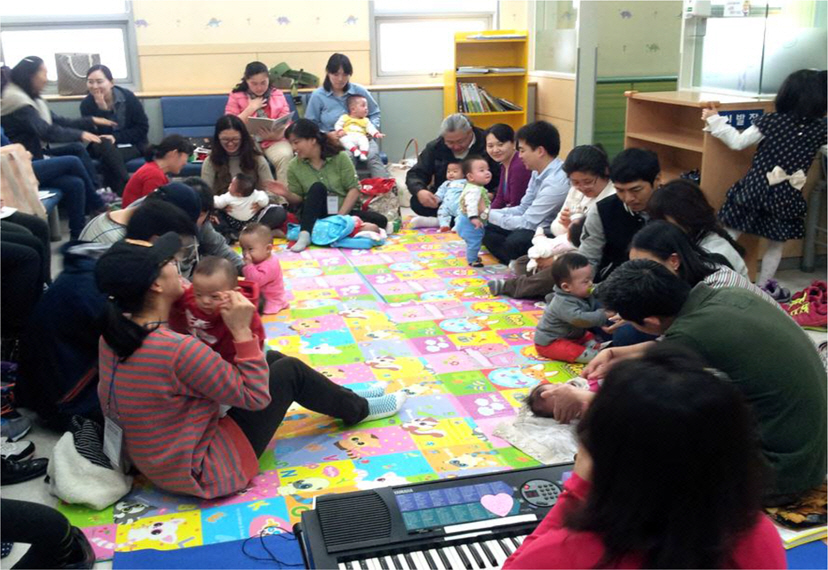Korean J Perinatol.
2014 Jun;25(2):75-82. 10.14734/kjp.2014.25.2.75.
Study on the Effects of the Family Support in the Very Low Birth Weight Infants Follow-Up: Focus on Dodam Dodam Bring-Up Center
- Affiliations
-
- 1Department of Nursing, Konkuk University, Chungju, Chungcheongbuk-do, Korea.
- 2Department of Pediatrics, Seogwipo Medical Center, Jeju, Korea.
- 3Department of Pediatrics, Konkuk University School of Medicine, Seoul, Korea. kmh@kuh.ac.kr
- KMID: 2280957
- DOI: http://doi.org/10.14734/kjp.2014.25.2.75
Abstract
- PURPOSE
After discharge from the hospital, very low birth weight infants require care consultation, information, and interaction and so forth, due to sequelae, different growth and developmental pattern; which increase the burdens and the worries of patients in nurturing them. With the counseling of experts in the related fields, the authors and the Food for the Hungry have run a department of childcare for a year, emphasizing on more family support than extreme early detection of disabilities. This study reports on relieving child care anxiety, promoting growth and development, educating parents on home treatment of sequelae, finding and coping with minor disabilities.
METHODS
The subjects were chosen among infants under 1,500 g of birth weight and younger than a corrected age of 6 months. Meetings were held once in a month for a year. Infant care support classes were taught by experts in their fields including a music therapist (with play program), neonatologist, a children's nurse, a child-care director, a clinical psychologist, a rehabilitation therapist, a social worker and, a nutritionist. Within the self-dependent groups, the families were able to share their concerns and experiences on child-caring. Second home visits were carried out to monitor home oxygen therapy, tube feeding, cerebral palsy signs, and to find neglect or abuse in suspected cases.
RESULTS
Fifty-one infants participated; the average weight was 1,060 g, the average gestational age was 27 weeks and 2 days. Eighteen were boys and 23 girls. The average age of the mothers was 33.4, and there were 26 appropriate for gestational age, 8 small for gestational age, and, 5 large for gestational age. Twenty three were first-born, 13 were second-born, 1 was third-born, and twins were 4 pairs. Home visits were done in 33 families, and secondary visits were done in 6 families. The depression score of mothers in the attendant group decreased from 10.47+/-5.18 to 8.18+/-5.87 (P=0.080).
CONCLUSION
The depression score of mothers in the attendant group decreased after infant care support classes.
MeSH Terms
Figure
Reference
-
1.Kim MH. Changes in birth rates of low birth weight and premature infants in Korea over the past 7 years. Korean J Pediatr. 2008. 51:233–6.
Article2.Korean statistical information service. Birth satatistics.(cited 2012 Oct.26) Available from:. http://www.kosis.kr/.3.Bae CW. Neonatal epidemiology in Korea: Statistics and clinical data. 1st ed. Seoul: ShinHeung MedScience, Inc. 2012, p.47–51.4.Hahn WH., Chang JY., Bae CW. Birth statistics and mortality rates for neonatal intensive unites in Korea during 2007: collective results from 57 hospitals. J Korean Soc Neonatol. 2009. 16:36–47.5.Allen MC. Preterm outcomes research: a critical component of neonatal intensive care, Ment Retard Dev Disabil Res Rev. 2002. 8:221–33.
Article6.Marlow N., Hennessy EM., Bracewell MA., Wolke D. Motor and executive function at 6 years of age after extremely preterm births. Pediatrics. 2007. 120:793–804.7.Alyward GP. Neurodevelopmental outcomes of infants born prematurely. J Dev Behav Pediatr. 2005. 26:427–40.8.Wood NS., Marlow N., Costelbe K., Gibson AT., Wlikinson AR. Neurologic and developmental disability after extremely preterm birth. N Engl J Med. 2000. 343:378–84.
Article9.Mishima J., Kono . Follow up Manual of high risk infants. 1st ed.Tokyo: Medical view;2007. p. p. 88–98.10.Utsumi H. Infant medical examination for support of nursing. Journal of the Japan pediatric association. 2011. 41:13–5.11.Kim MH. Infant born under 1000 g-New standard care 1st ed. ShinHeung MedScience, Inc;2007. p. p. 196–210.12.Sung IK. Follow-up of high risk infants. J Korean Med Assoc. 1994. 37:340–6.13.Kim AR. Infant follow-up of premature infants. J Korean Med Assoc. 2005. 48:1091–100.
Article14.Beck AT., Ward CH., Mendelson M., Mock J., Erbaugh J. An inventory for measuring depression, Archives of General Psychiatry. 1961. 4:561–71.15.Liu CH., Chao YH., Huang CM., Wei FC., Chien LY. Effectiveness of applying empowerment strategies when establishing a support group for parents of preterm infants. J Clin Nurs. 2010. 19:1729–37.
Article16.Matsuda HO. Support of high risk infant nursing. Journal of the Japan Society for Premature and Newborn Medicine. 1999. 11:7–12.17.Kim MH. Infant born under 1000g-New standard of care 1st ed: ShinHeung MedScience, Inc. 2007. p. 218–21.18.Woo MK., Kim DW., Hur K., Shim GH., Chey MJ. Study on the neurodevelopmental predictors for the results of the Bayley scales of infant development II in high-risk infants. Korean J Pediatr. 2009. 52:1221–7.19.Eun BL. Early detect of infant developmental abnormality. Proceedings of the 63th Annual Spring Meeting of the Korean Pediatric Society; 2013 Apr 19; chungjoo. Seoul: The Korean Pediatric Society. 2013.20.Bae JW., Kim MH. Practice of clinical neonatology 1st ed, Han-kook medicine Publishers, 2004. p. 46–51.21.Kim MH. Systemic review of CLD treatment 1st ed, Shin-Heung MedScience, Inc. 2007. p. 114–5.22.Fukui S. Think about support of nursing. The Journal of Japan Pediatric Association. 2012. 43:190.23.Udou YK. Infant nursing of changing aspect on family condition, Journal of japan academy of neonatal nursing. 2008. 14:1.24.Ando TK. Perinatal mental care. Japanese Journal of Maternal Health. 2012. 53:8–14.
- Full Text Links
- Actions
-
Cited
- CITED
-
- Close
- Share
- Similar articles
-
- Effects of Music Intervention Techniques on Very-Low-Birth-Weight Infants in Neonatal Intensive Care Unit: A Preliminary Study
- Comparison of Maternal Self-esteem, Postpartal Depression, and Family Function in Mothers of Normal and of Low Birth-weight Infants
- The Effects of Follow-Up Care on Social Support, Self-esteem and Maternal Confidence in Low Birth-weight Infant's Mothers
- Follow Up Study of the Low Birth Weight Infants Less than Birth Weight 1,500 grams
- Rehospitalization of Low-birth-weight Infants Who Were Discharged from NICU


